
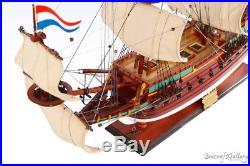
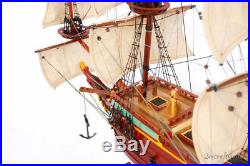
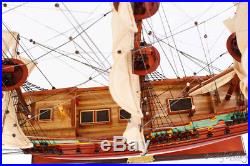
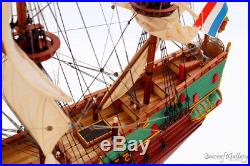
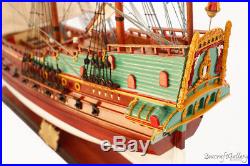
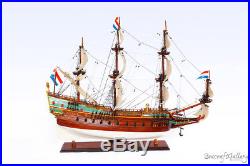
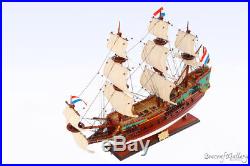

Features of the model. Dimension approximately: 95cm L x 20cm W x 78cm H. This model is assembled and ready to display. Entirely hand built by using individual wooden planks in hull construction. We use the high quality wood in constructing and ensuring the model will withstand with climate change. Anchors, decorative fixtures and intricate details are sculpted of metal. Sails are handmade of fine linen and rigging lines vary in texture. Handcrafted according to scale through original plans and pictures. This model comes with a solid wood base, a metal name plate. On October 29, 1628, the newly built Batavia, commissioned by the Dutch East India Company, sailed from Texel for the Dutch East Indies to obtain spices. It sailed under Commandeur and “opperkoopman” (senior merchant) Francois Pelsaert, with skipper Adriaen Jacobsz. These two had previously encountered each other in Surat, India. Although some animosity had developed between them there, it is not known whether Pelsaert even remembered Jacobsz when he boarded Batavia. Also on board was the “onderkoopman” (under merchant) Jeronimus Cornelisz, a bankrupt pharmacist from Haarlem who was fleeing the Netherlands in fear of arrest because of his heretical beliefs. Jacobsz and Cornelisz had already gathered a group of men around them and arranged an incident from which the mutiny was to ensue. This involved attacking a young female passenger on board in order to provoke Pelsaert into disciplining the crew. They hoped to paint his discipline as unfair and recruit more members out of sympathy. However, Pelsaert made no arrests and the mutineers were forced to wait. An initial survey of the islands found no fresh water and limited food (sea lions and birds). Leaving 268 people behind, a group comprising the captain, senior officers, Francisco Pelsaert, a few crewmembers, and some passengers, left the wreck site in a thirty-foot longboat (a replica of which has also been made) in search of drinking water. After an unsuccessful search for water on the mainland, the group headed north to the city of Batavia, now Jakarta. This journey, which ranks as one of the greatest navigation feats of the day, took thirty-three days and all aboard survived. After their arrival in Batavia, Pelsaert was sent back to rescue the other survivors. He arrived at the site two months after leaving Batavia on the vessel Saardam, only to discover that a mutiny had taken place. Jeronimus Cornelisz was well aware that if the longboat party ever reached Batavia, Pelsaert would report the impending mutiny and Jakobsz would put the blame on him. He even made plans to start a new kingdom. For this, he needed to eliminate any possible opponents. Although Cornelisz never committed any murders himself, he used his powers of persuasion to coerce others into doing the dirty work for him. His followers murdered a total of 125 men, women, and children, after moving a group of soldiers led by Wiebbe Hayes to a nearby island (West Wallabi) under false pretenses. Pelsaert arrived just as Cornelisz’s men were trying to eliminate the remaining group, and the combined force captured the mutineers after a short battle. After a brief trial the worst offenders, including Cornelisz, were executed on the island. Two young sailors, considered only minor offenders, were marooned on mainland Australia, never to be heard of again. Reports of unusually light-skinned Aborigines in the area by later British settlers has been suggested as evidence that the two men might have been adopted into a local Aboriginal clan. However, numerous other European shipwreck survivors, such as those from the wreck of the Zuytdorp in the same region in 1712, may also have had such contact with indigenous inhabitants. The lesser offenders were tried in Batavia where most were executed after being punished by flogging, keelhauling and being dropped from the yard arm. Cornelisz’s second in command was broken on the wheel. Despite being tortured, Jakobsz did not confess to his part in planning the mutiny, and thereby escaped execution due to lack of evidence. What finally happened to him is not known, but it is suspected that he died in prison in Batavia. Pelsaert was held partly responsible for what happened because of lack of authority. Wiebbe Hayes was promoted. Of the original 341 on board Batavia, only 68 made it to port of Batavia, the final destination. Seacraft Gallery brings you the highest-quality model ships found anywhere. We know how important it is to you that your model arrives in perfect condition. You can order with confidence that when you receive your model, you will love it! The model, safely surrounded by its wood frame, is then placed inside of a heavy, industrial-strength cardboard box. The box is marked with “This Side Up” and “Fragile” stickers to ensure that it is handled properly. Check anytime to see exactly when your model is expected to arrive. If you sign for the goods in’Good Condition’ you will not be able to process a claim. You Might Also Like. HMS Victory painted 75cm. Queen Mary 2 80cm. Australia II Yacht 40cm. The item “NEW BATAVIA 95CM HANDCRAFTED WOODEN MODEL TALL SHIP BOAT GIFT DECORATION” is in sale since Monday, January 5, 2015. This item is in the category “Collectables\Transportation\Automobilia”. The seller is “seacraftgallery” and is located in Yagoona. This item can be shipped worldwide.
- Brand: Seacraft Gallery
